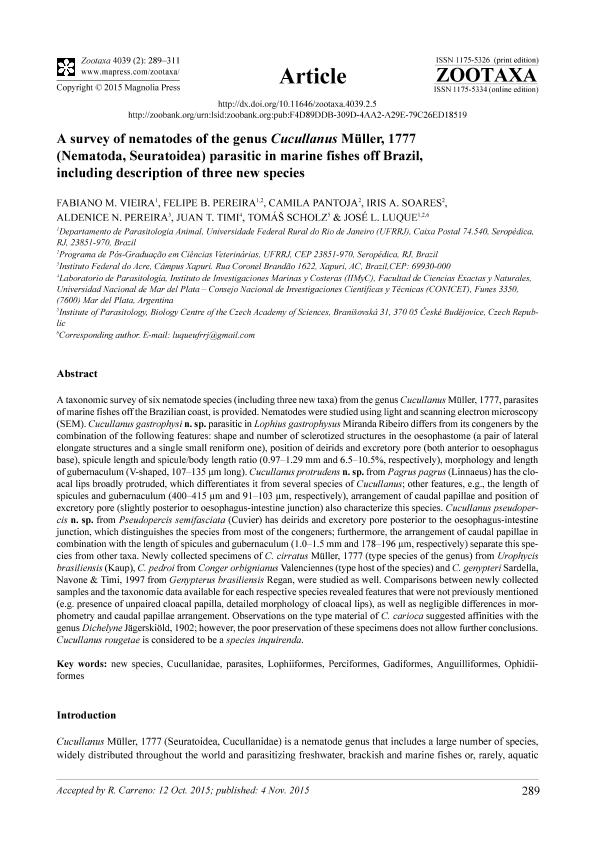Artículo
A survey of nematodes of the genus Cucullanus Müller, 1777 (Nematoda, Seuratoidea) parasitic in marine fishes off Brazil, including description of three new species
Vieira, Fabiano M.; Pereira, Felipe B.; Pantoja, Camila; Soares, Iris A.; Pereira, Aldenice N.; Timi, Juan Tomas ; Scholz, Tomás; Luque, José L.
; Scholz, Tomás; Luque, José L.
 ; Scholz, Tomás; Luque, José L.
; Scholz, Tomás; Luque, José L.
Fecha de publicación:
11/2015
Editorial:
Magnolia Press
Revista:
Zootaxa
ISSN:
1175-5326
Idioma:
Inglés
Tipo de recurso:
Artículo publicado
Clasificación temática:
Resumen
A taxonomic survey of six nematode species (including three new taxa) from the genus Cucullanus Müller, 1777, parasites of marine fishes off the Brazilian coast, is provided. Nematodes were studied using light and scanning electron microscopy (SEM). Cucullanus gastrophysi n. sp. parasitic in Lophius gastrophysus Miranda Ribeiro differs from its congeners by the combination of the following features: shape and number of sclerotized structures in the oesophastome (a pair of lateral elongate structures and a single small reniform one), position of deirids and excretory pore (both anterior to oesophagus base), spicule length and spicule/body length ratio (0.97-1.29 mm and 6.5-10.5%, respectively), morphology and length of gubernaculum (V-shaped, 107-135 m long). Cucullanus protrudens n. sp. from Pagrus pagrus (Linnaeus) has the cloacal lips broadly protruded, which differentiates it from several species of Cucullanus; other features, e.g., the length of spicules and gubernaculum (400-415 m and 91-103 m, respectively), arrangement of caudal papillae and position of excretory pore (slightly posterior to oesophagus-intestine junction) also characterize this species. Cucullanus pseudopercis n. sp. from Pseudopercis semifasciata (Cuvier) has deirids and excretory pore posterior to the oesophagus-intestine junction, which distinguishes the species from most of the congeners; furthermore, the arrangement of caudal papillae in combination with the length of spicules and gubernaculum (1.0-1.5 mm and 178-196 m, respectively) separate this species from other taxa. Newly collected specimens of C. cirratus Müller, 1777 (type species of the genus) from Urophycis brasiliensis (Kaup), C. pedroi from Conger orbignianus Valenciennes (type host of the species) and C. genypteri Sardella, Navone & Timi, 1997 from Genypterus brasiliensis Regan, were studied as well. Comparisons between newly collected samples and the taxonomic data available for each respective species revealed features that were not previously mentioned (e.g. presence of unpaired cloacal papilla, detailed morphology of cloacal lips), as well as negligible differences in morphometry and caudal papillae arrangement. Observations on the type material of C. carioca suggested affinities with the genus Dichelyne Jägerskiöld, 1902; however, the poor preservation of these specimens does not allow further conclusions. Cucullanus rougetae is considered to be a species inquirenda.
Archivos asociados
Licencia
Identificadores
Colecciones
Articulos(IIMYC)
Articulos de INSTITUTO DE INVESTIGACIONES MARINAS Y COSTERAS
Articulos de INSTITUTO DE INVESTIGACIONES MARINAS Y COSTERAS
Citación
Vieira, Fabiano M.; Pereira, Felipe B.; Pantoja, Camila; Soares, Iris A.; Pereira, Aldenice N.; et al.; A survey of nematodes of the genus Cucullanus Müller, 1777 (Nematoda, Seuratoidea) parasitic in marine fishes off Brazil, including description of three new species; Magnolia Press; Zootaxa; 4039; 2; 11-2015; 289-311
Compartir
Altmétricas



